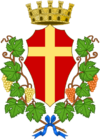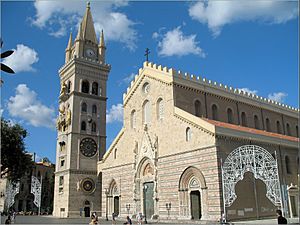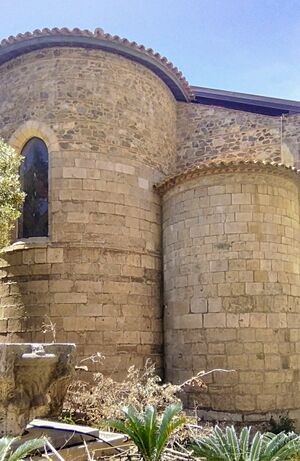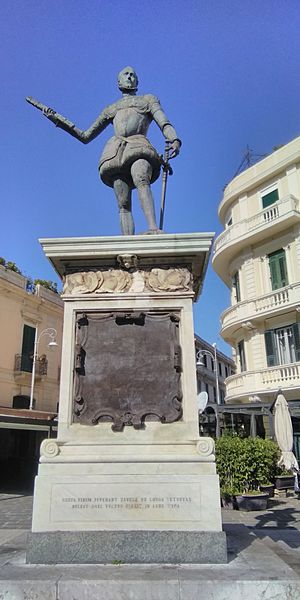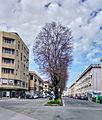Messina facts for kids
Quick facts for kids
Messina
|
|||
|---|---|---|---|
| Comune di Messina | |||
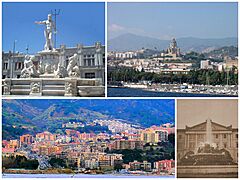 |
|||
|
|||
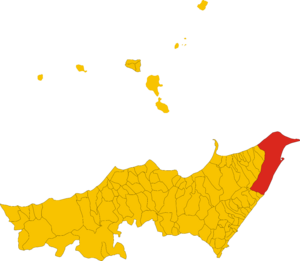
Position of the commune in the Metropolitan City
|
|||
| Country | Italy | ||
| Region | Sicily | ||
| Area | |||
| • Total | 213.23 km2 (82.33 sq mi) | ||
| Elevation | 3 m (10 ft) | ||
| Population
(1 January 2023)
|
|||
| • Total | 218,786 | ||
| • Density | 1,026.056/km2 (2,657.47/sq mi) | ||
| Demonym(s) | Messinese | ||
| Time zone | UTC+1 (CET) | ||
| • Summer (DST) | UTC+2 (CEST) | ||
| Postal code |
98100
|
||
| Dialing code | 090 | ||
| Patron saint | Madonna of the Letter | ||
| Saint day | June 3 | ||
Messina is an important port city in Italy. It is the capital of the Metropolitan City of Messina in Sicily. This makes it a very important place for trade and travel.
Messina is the third largest city on the island of Sicily. It is also the 13th largest city in all of Italy. More than 218,000 people live in the city itself. About 650,000 people live in the wider metropolitan area.
The city is located in the northeast corner of Sicily. It sits right by the Strait of Messina. This strait is a narrow passage of water that separates Sicily from mainland Italy. Messina is a key entry point to the Calabria region, connecting to cities like Villa San Giovanni and Reggio Calabria.
Messina's main activities include its busy seaports. These ports are used for both commercial ships and military vessels. Cruise ships also visit, bringing many tourists. Other important parts of the city's economy are trade and farming. Farmers here grow lemons, oranges, mandarin oranges, and olives. They also produce wine.
Messina has been a major religious center since 1548. It is home to the University of Messina, which was founded in 1548 by Ignatius of Loyola.
Contents
A Look Back in Time: History of Messina
Messina has a very long and interesting history. It was first settled by Greek colonists around 800 BC. They called it Zancle, which means "scythe". This name came from the shape of its natural harbor.
In the early 400s BC, the city was renamed Messene. This was done to honor another Greek city called Messene. Over the centuries, Messina faced many conflicts. It was attacked by the Carthaginians in 397 BC. Later, Dionysius I of Syracuse took it back.
Ancient Times and Roman Rule
Around 288 BC, a group called the Mamertines took over the city. They used Messina as a base to raid the countryside. This led to a conflict with Syracuse. Hiero II, the ruler of Syracuse, defeated the Mamertines and surrounded Messina.
Carthage helped the Mamertines because they were also rivals with Syracuse. When Hiero attacked again in 264 BC, the Mamertines asked the Roman Republic for help. Rome decided to form an alliance with them. This was the first time a Roman army fought outside the Italian Peninsula. After the First Punic War, Messina became a free city allied with Rome. During Roman times, it was known as Messana and had an important lighthouse.
Medieval Period and Crusades
After the Western Roman Empire fell, Messina was ruled by different groups. These included the Goths (from 476 AD), the Byzantine Empire (from 535 AD), and the Arabs (from 842 AD). In 1061, the Normans took control.
In 1189, the English King Richard I, also known as "The Lionheart," stopped in Messina. He was on his way to the Holy Land for the Third Crusade. He briefly took over the city after a disagreement.
Revolts and the Black Death
Messina was one of the most important cities in Sicily. It was often caught in conflicts between powerful families. In 1282, the city joined the Sicilian Vespers revolt. This led to a major siege by Charles I of Anjou.
In 1347, Messina became one of the first places in Western Europe to be hit by the black death. Ships from an infected city arrived in Messina's port. Many people on board were already dead or dying. The plague quickly spread from Messina into mainland Italy.
Spanish Rule and Decline
In 1548, St. Ignatius founded the world's first Jesuit college in Messina. This college later became the University of Messina. The Christian ships that won the famous Battle of Lepanto (1571) sailed from Messina. The Spanish writer Miguel de Cervantes, who fought in the battle, recovered in Messina's hospital.
The city was at its best in the early 1600s under Spanish rule. At that time, it was one of the ten largest cities in Europe. However, in 1674, the city rebelled against the Spanish. With help from the French king Louis XIV, Messina was independent for a short time. But in 1678, the Spanish reconquered and looted the city. They took away its university, senate, and all its special rights. A huge fortress was built, and Messina began to decline. In 1743, a second wave of plague killed 48,000 people in the city.
Earthquakes and Rebuilding
In 1783, a powerful earthquake destroyed much of Messina. It took many decades to rebuild the city. In 1847, Messina was one of the first Italian cities to see Risorgimento riots. These riots were part of the movement to unite Italy. In 1848, the city openly rebelled again but was put down.
Finally, in 1860, Garibaldi's troops took the city. This was part of the unification of Italy. Another earthquake hit in 1894. But the worst disaster was on December 28, 1908. A massive earthquake and tsunami almost completely destroyed the city. About 100,000 people died, and most of the old buildings were ruined. The city was largely rebuilt in the years that followed.
World War II and Modern Times
Messina suffered more damage during World War II. In 1943, it was heavily bombed by Allied forces. This was because it was a key point for Axis troops and supplies going to Sicily. These bombings destroyed one-third of the city and killed 854 people. The city received special awards for its bravery and efforts to rebuild.
In June 1955, Messina hosted the Messina Conference. This meeting of Western European foreign ministers led to the creation of the European Economic Community, which was a big step towards the modern European Union.
Today, Messina is home to a small group of people who speak Greek. They arrived from the Peloponnese in the 1530s, escaping the Ottoman Empire. They were officially recognized in 2012.
Geography and Climate
Messina is located on the coast and has a Mediterranean climate. This means it has long, hot summers that are usually dry. Winters are mild and tend to be wet. Even in winter, temperatures usually stay above 10°C (50°F). Messina gets more rain than Reggio Calabria, which is just across the Strait of Messina. This is a surprising difference for such a short distance.
Main Sights: What to See in Messina
Messina has many interesting places to visit, from ancient churches to beautiful fountains.

Religious Buildings
- The Cathedral (built in the 12th century) holds the remains of King Conrad IV of Germany. He ruled Germany and Sicily in the 1200s. The cathedral was almost completely rebuilt after the 1908 earthquake and again after a fire in 1943. You can still see parts of the original Norman architecture. The front of the building has three beautiful Gothic doorways. Inside, there are 28 columns dividing the main area. The bell tower has the Messina astronomical clock, one of the largest in the world. Every day at noon, its mechanical statues move, telling stories from the city's history. This is a popular sight for tourists.
- The Sanctuary of Santa Maria del Carmelo (built in 1931) has a statue of the Virgin Mary from the 1600s.
- The Sanctuary of Montevergine keeps the preserved body of Saint Eustochia Smeralda Calafato.
- The Church of the Santissima Annunziata dei Catalani (late 12th–13th century) is from the Norman period. It has a round apse and a tall dome. The outside decorations show Arabic influences with blind arches and small columns.
- The Church of Santa Maria degli Alemanni (early 13th century) was once a chapel for the Teutonic Knights. It is a rare example of pure Gothic style in Sicily, with its arched windows and strong buttresses.
Civil and Military Buildings
- The Botanical Garden Pietro Castelli is part of the University of Messina.
- The Palazzo Calapaj-d'Alcontresj is an example of 18th-century architecture. It is one of the few noble palaces that survived the 1908 earthquake.
- The Forte del Santissimo Salvatore is a 16th-century fort in the Port of Messina.
- The Forte Gonzaga is another 16th-century fort that overlooks Messina.
- The Porta Grazia is a 17th-century gate from the "Real Cittadella di Messina," a fortress still in the harbor.
- The Pylon was built in 1957. It was once the highest electric pylon in the world. Even though the power line is now underwater, the pylon is still a tourist attraction.
- The San Ranieri lighthouse was built in 1555.
- The Palazzo della Provincia (Palazzo dei Leoni) is the provincial government building, built in 1914.
- The Palace of Culture was built in 2009.
Monuments and Sculptures
- The Fountain of Orion is a large sculpture next to the cathedral. It was built in 1547 by Giovanni Angelo Montorsoli, a student of Michelangelo. An art historian called it "the most beautiful fountain of the sixteenth century in Europe."
- The Fountain of Neptune faces the harbor and was also built by Montorsoli in 1557.
- The monument to John of Austria was made by Andrea Camalech in 1572.
- The Senatory Fountain was built in 1619.
- The Four Fountains: Only two parts of this complex from the 17th-18th centuries remain today.
Museums to Explore
- The Museo Regionale di Messina (MuMe) has important paintings. These include works by famous artists like Caravaggio and Antonello da Messina.
- The Galleria d'Arte Contemporanea di Messina displays modern art. It features paintings by artists such as Renato Guttuso and Lucio Fontana.
Getting Around: Public Transport
Messina has a good public transport system.
Train Travel
The main train station is Messina Centrale. It is connected to the Messina Marittima station, which is by the port. From here, you can take a ferry across the Strait of Messina to Villa San Giovanni on the mainland. In 2021, Messina's harbor was the busiest passenger port in Europe. Over 8.2 million people crossed by ferry in one year.
The station has regional trains. For longer trips, there are night trains to cities like Rome, Milan, and Venice. Since 2010, there's also a local train service that runs along the coast.
Buses and Trams
Messina's public bus system is run by ATM Messina. In 2018, they improved the bus services. There is a main bus line (Line 1 - Shuttle 100) that covers 38 kilometers of the city's coast. This line connects with other bus routes and the tram.
The modern Messina tramway opened in 2003. This tram line is 7.7 kilometers long. It links the main train station with the city center and the harbor. The city plans to buy more buses and improve its electronic ticketing system.
Sports Teams
Messina has a few sports teams:
- A.C.R. Messina
- S.S.D. Città di Messina
Famous People from Messina
Many notable people have come from Messina. Here are a few examples:
Actors
- Adolfo Celi (1922–1986)
- Maria Grazia Cucinotta (born 1968)
- Nino Frassica (born 1950)
Artists and Designers
- Antonello da Messina (1430–1479), a very important painter from the Renaissance period.
- Filippo Juvarra (1678–1736), a famous Baroque architect.
Politicians and Military Figures
- Giuseppe La Farina (1815–1863), a leader in the Italian unification movement.
- Luigi Rizzo (1887–1951), a naval officer and hero from World War I.
Musicians
- Alberto Urso (born 1997), a singer.
Religious Figures
- Eustochia Smeralda Calafato (1434–1485), a saint.
- Annibale Maria Di Francia (1851–1927), a saint.
- Pope Leo II (611–683), a former leader of the Catholic Church.
Sports Stars
- Tony Cairoli (born 1985), a motocross world champion.
- Vincenzo Nibali (born 1984), a famous cyclist.
Researchers and Academics
- Francesco Maurolico (1494–1575), an astronomer and mathematician.
Sister Cities
Messina has "sister city" relationships with:
Images for kids
-
13th-century coins minted during the reign of Frederick II.
-
A tract of around 30 kilometres of beaches of Messina.
-
The Feluca, a typical boat used by the fishermen of Messina to hunt swordfish.
-
The giants Mata and Grifone, whose stories are told about the city, are brought around Messina during the second week of August.
See also
 In Spanish: Mesina para niños
In Spanish: Mesina para niños



